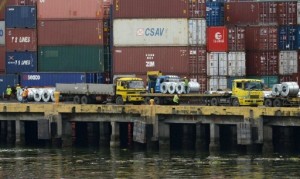
Shipping containers of Philippine products for export sit stacked along the docks of the international container port in Manila on September 11, 2012. The contribution of exports to the Philippine economy may shrink in the years ahead given the bleak growth prospects in major export markets, the Bangko Sentral ng Pilipinas said Monday, Nov. 5, 2012. AFP PHOTO/JAY DIRECTO
The contribution of exports to the Philippine economy may shrink in the years ahead given the bleak growth prospects in major export markets, the Bangko Sentral ng Pilipinas said Monday.
However, it said the Philippines was expected to hit its medium-term growth targets despite a slowdown in exports.
The BSP said the crisis that continued to grip the eurozone and the lackluster performance of the US economy would continue to drag Philippine export earnings.
The adverse effects of anemic exports on the economy’s growth are seen to be offset by higher spending by Filipino households and businesses. As such, the Philippines was still poised to achieve its growth targets in the coming years, the monetary agency added.
“The export sector remains an important driver of economic growth and provider of jobs. However, given the difficult global markets, it would be a big challenge for exports to sustain its role in the economy,” BSP Deputy Governor Diwa Guinigundo told the Inquirer.
“[But] domestic demand will be an important element in a rebalancing effort in sustaining the growth momentum of the economy,” he added.
Exports account for roughly 30 percent of the Philippines’ gross domestic product (GDP).
The National Statistics Office earlier reported that the country’s exports fell 9 percent year on year to $3.8 billion in August. Falling export earnings of the Philippines and other emerging markets were attributed largely to the economic problems of the United States and the eurozone, two of the biggest export markets.
Exports in August brought the total for the first eight months of the year to $35.28 billion, up year on year by 5.4 percent.
Export industry players in the Philippines said that latest developments indicated that the 10-percent export growth target for this year was no longer attainable.
The government has set an economic growth target of between 5 and 6 percent this year, 6 and 7 percent in 2013, and at least 7 percent in the succeeding years.
According to the BSP, inflation was expected to remain manageable and within the target range of 3 to 5 percent until 2014. Relatively stable consumer prices allow interest rates to stay low as well.
The central bank said it believed an environment of low inflation and low interest rates would encourage people to spend and businesses to purchase capital and invest more.
It expressed confidence that the favorable economic fundamentals of the country would help encourage more foreign direct investments and infusions from local firms.
“Private investments not only in [infrastructure projects under the] PPP but also in other sectors like manufacturing, construction and agro-industries could be the other counterweight to weak [export earnings],” Guinigundo said.
The Public-Private Partnership, or PPP, is a program in which private firms are invited to invest in public infrastructure projects.

